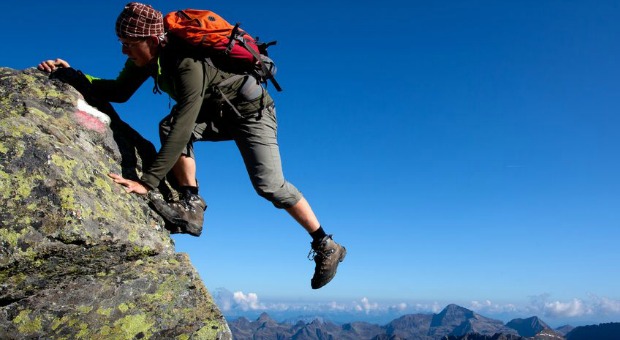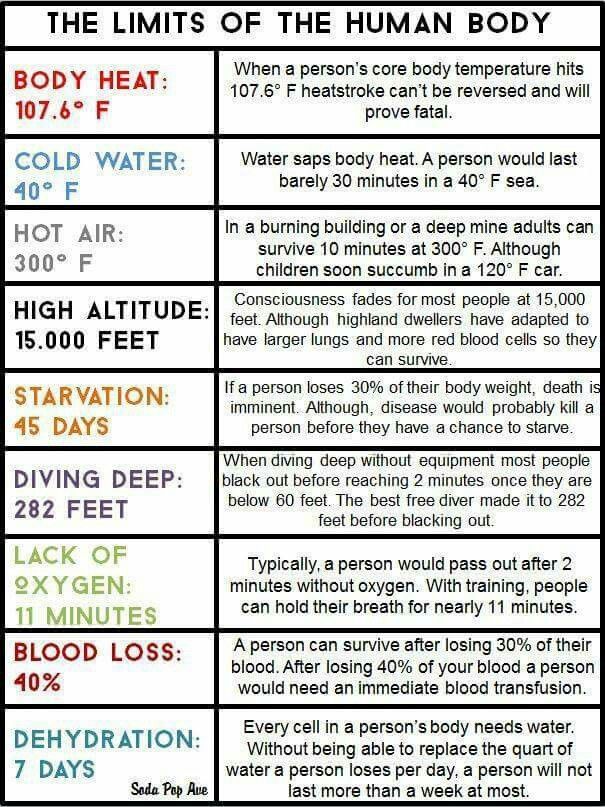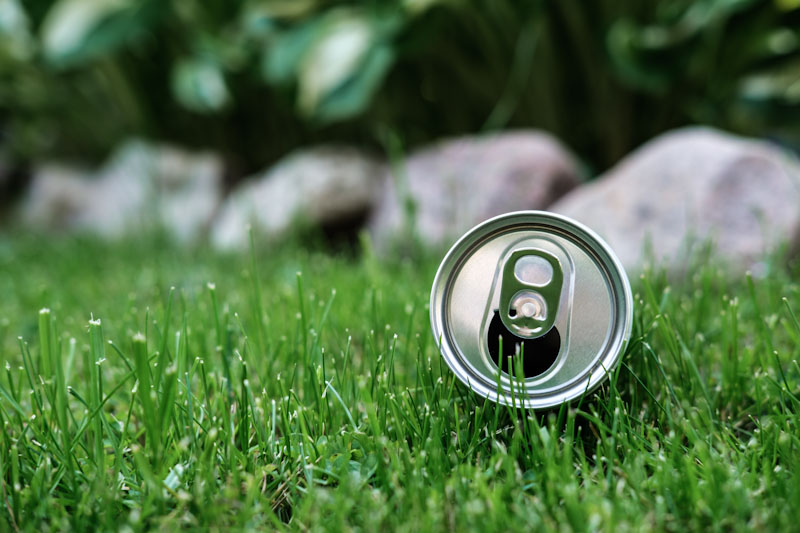The human body is amazingly adaptable, able to survive in a wide range of conditions, and through suffering a wide range of circumstances.
We’ve all heard of people who have survived being shot in the heart or even in the brain. While those are supposedly impossible situations to survive, some people do survive them. Likewise, people have survived the harshest climate that nature can throw at them, as well as the worst hell that mankind can create.
Many of us don’t know the limits of their body and how strong they are but your body can take a lot more than you think when pushing its limits to survival.
There are some limits to human survival which have been well mapped out. We all know the rule of 3, which defines how long we can live without some of our most basic survival needs. But even then, there are extreme cases where people have done the impossible and survived past those limits.
Then there are a wide range of challenges which are unknowns, as the limit has never been fully mapped out. How long can a person survive without sleep? The longest on record is 11 days, but while the test subject was little more coherent than a vegetable at the end of that time, they were in no risk of dying.
The same can be said for a wide range of athletic achievements. For a long time, it was believed that humans could not beat the four-minute-mile. Then Roger Bannister ran a mile in 3:59:4, back in 1954. Once he did that, others were able to break through that barrier, till today, the fastest mile on record is almost 17 seconds faster than Bannister’s record-breaking time.
This is not uncommon in athletics, as every record broken becomes a new challenge to other athletes. Today’s Olympic athletes can outperform those of a century ago by so far, as to make those in the past look like a bunch of bumbling fools. Yet in their day, each of them was a marvel of human accomplishment.
Every time a new record has been set, either by athletes or by people who survive seemingly impossible situations, scientists are forced to rethink their understanding of the human body’s abilities. Yet just because one person succeeds in surviving a specific situation, that doesn’t mean that all people can.
People fall off of buildings and survive, even buildings as tall as ten stories high. In most cases, falling 100 feet like that would result in death or at least extremely severe injury. But there are always those rare cases of people who survive such a fall, and seem to do so, without serious injury.
In some cases, that can be attributed to the individual being drunk. Drinking to excess causes the muscles to relax, amongst the other effects it has. It also makes the drunk person less aware of their surroundings and what is happening to them. Without that awareness, they can fall off a building and not tense their muscles in expectation to the sudden stop at the bottom. This can actually help them to survive, as a relaxed body will often suffer less injury than a tense one.
But that doesn’t mean that we should all walk around drunk, or that being drunk when falling off a building would ensure our survival. There are many factors in play in any such accident; such as the individual’s physical condition, their health, how they strike the ground, the surface they land on and how their body collapses upon impact.
Then there’s the many differences in individual bodies, as no two people are exactly the same.
Strong muscles not only provide the strength and endurance necessary to perform survival tasks, they also help prevent injury. Many bone and ligament injuries happen simply because of a lack of muscle strength. If muscles are strong enough, they protect the bones as well, acting as a cushion. Fat can’t do that.
All this affects our ability to survive much more than a fall. In any survival situation, these same factors come into play. One person might be able to withstand cold well, while another may do better in the heat. Some can eat foods that might be considered tainted, without suffering any harm, while others have systems which are easily affected by even the slightest thing wrong with their food.
While some of this is beyond our control, there are things which we can do, which will ultimately increase our ability to survive. If one is forced to bug out from their home on foot, both strength and endurance will come into play.
Strength will affect how much they are able to carry with them, while endurance will affect how far they can walk, before they have to stop and take a break. Each has its value, so to concentrate on one, to the exclusion of the other, is not the best training strategy.
3 Second SEAL Test Will Tell You If You’ll Survive A SHTF Situation
Explore Your Limits
Before you start training, you need to know where you are right now. What are your body’s limits? What can you withstand? Knowing the generalities of what “most people” can withstand isn’t enough, you need to know what works for you.
Knowing that people can survive living in a temperature range from 40°F to °F to 95°F won’t help you a bit, if you don’t know how your body reacts to heat and cold. So you need to put yourself into circumstances where you are forced to function for a prolonged period of time in those temperatures, and monitor how well you do.
Do you lose strength quickly when it’s hot? Does cold weather make your joints stiffen? How much do you sweat when it’s hot and how much does physical activity affect that?
Your ability to withstand extremes in temperature need to be evaluated over time, as your body will gradually adjust to those extremes.
Explorers who go to the Arctic or Antarctica spend time acclimating to the cold, before starting their explorations. Given time, their bodies adjust, making it possible for them to survive in circumstances where others couldn’t.
Establish Real Life Strength and Endurance Tests
You can test yourself for strength and endurance fairly easily. Just don’t do it at your local gym. While the gym might be great for physical fitness training, it’s an unrealistic environment. Just because you can lift X number of pounds for 20 repetitions, or even 200 repetitions, doesn’t mean that you can wield an axe for three hours, splitting firewood. The effort and movement may seem similar, but it’s not. Weight training really only prepares you for more weight training, it doesn’t prepare you for real-life survival tasks.
Nor can endurance be measured on a stationary bicycle or elliptical machine. While that might give you a comparative evaluation of how you are today, compared to how you were a year ago, it won’t tell you how far you can hike through rugged terrain, carrying a 50 pound pack.
You’ve got to establish realistic tests, based upon real-life survival tasks. If you want to know how well you’ll handle carrying that pack on a bug out, go backpacking in the type of terrain that you expect to pass through while bugging out.
Make your pack as heavy as it would be on that bug out, or even a touch heavier. Dress yourself in the same way, and make sure you have good hiking boots on. Then see how well you do.
The same sort of test can be done for every survival task that you envision having to do. Split a pile of firewood, so you can see how long it will take and how many breaks you’ll need to take before getting done. Check how well your hands survive as well, as you might find them covered with blisters.
Please note here that most people will quit, long before they reach their limits. We tend to stop when we get tired, saying that we’re about to collapse. But in fact, we are far from collapsing; we’re just tired. We just don’t want to do any more.
I remember a time in my military service, when I was at that point, but circumstances forced me to go on. You know something? I did. I went well beyond what I thought were my limits, yet still didn’t reach the point of collapsing.
With your real-life tests in the log book, you can then go to the gym and do comparable tests. Put yourself through a workout, trying to do exercises that simulate your real-life survival tasks.
Record the results of those as well, right alongside the other tests. You can then use your progress in the gym, as an indication of how you might do in the field. It won’t be a perfect comparison, but an improvement in the gym should roughly equal a similar improvement in the field.
Develop Your Training Regimen for Survival
Let’s be honest with ourselves. Most of us aren’t in good enough shape for survival. I know I’m not. Having to hike all day, carrying a heavy pack or needing to split a pile of firewood is probably more than I can do. I’m not as young as I once was and I spend way too much time sitting in front of my computer.
But that doesn’t mean I have to stay that way. Physical training is just training. As such, it’s something that just about anyone can do. All we need is to develop the right sort of training regimen, and then to have the discipline to follow through.
That’s the keyword – discipline. It is the lack of discipline which prevents most of us from exercising. We know we should, we even know how to… but we still don’t do it. We lack the discipline.
“Our limits are mostly mental limits, not physical limits. Once we accept them as such, we should be able to change them.”
You can discipline yourself by simply motivating yourself. What’s your reason to push the limits of your body? To be able to survive, right? That desire to survive should be all the motivation you need. With it, you should be able to push yourself beyond what you think are your limits, finding new limits that you never even knew existed.
A number of years ago, trainers for the Olympic bicycling team tried an experiment with their cyclists. They started out telling them to ride as fast as they can, “sprinting” on the bicycle, if you will. Then, they told them to “follow” a video of someone else riding and stay right with them. Even though the videos were one or two miles per hour faster than their supposed “fastest time,” they were able to keep up.
There’s a secret that we can all use. That is, our limits are mostly mental limits, not physical limits. Once we accept them as such, we should be able to change them, simply by deciding that we can. In other words, starting out at our limit and then adding just a little bit more. By incrementally increasing our limit in this way, we push our body’s ability and find the ability to do more.
Video first seen on Outside.
Develop Toughness Too
Physical strength and endurance are important parts of survival. An individual who is in shape, is much more likely to accept and overcome the hardships of survival. Their body will rise to the challenge, putting for the necessary exertion to get through whatever survival problem.
But that body which is in condition will be able to withstand the rigors better, as well. They won’t just be able to do more, but they will suffer less in doing so. Part of that is the physical toughness that goes with being physically in shape.
Fighter of all kinds work to develop toughness, right alongside strength, endurance and agility. What do I mean by that physical toughness? It’s the ability to take the blows, without it affecting you. It’s pretty much impossible to have physical toughness, without physical conditioning. But it is possible to have that physical conditioning, without the toughness to go with it.
Physical toughness is developed by taking blows. Muscles which are hardened by exercise can take those blows, without it doing them harm. This is especially true when the muscles are flexed, hardening them.
If your abdominal muscles are relaxed and someone hits you in the belly, it will hurt. It might even tear some muscle or cause other damage. But if you are given the opportunity to tighten those muscles, before the blow, you will withstand the same blow, without harm. If your abdominal muscles are in shape, you’ll be able to take a much stronger blow, without harm.
But there’s another side of toughness, besides physical toughness, that’s mental toughness. Physical toughness is something that you can train your body to have, while mental toughness is something you must train your mind to have.
Put simply, mental toughness is the ability to push on through and not give up. As I mentioned before, most of us give up before we reach our limit. This doesn’t just apply to endurance, but to everything. Having mental toughness means that we won’t quit, no matter how tired we are, how much we hurt, or how impossible the situation looks.
Probably the greatest experts in mental toughness today are the Navy Seals. Seal training is reported to be the toughest military training there is. But they make it extremely easy to quit. A trainee can quit at any time, no questions asked. There’s a bell just outside the main office, where it can be seen by all, all the way through their training. All they have to do is trot over to that bell and ring it. One clang of the bell and you’re given a warm blanket, a cup of coffee, a donut and a fast trip out of Seal training.
They make it easy to quit, because the Seals are looking for people who aren’t quitters. One of the things that makes them so effective, is that the Seals are made of people who won’t quit, no matter what.
Seals are survivors. They’re people who don’t know how to quit. They’ve got the mental toughness to keep on trying, no matter what. Work on yourself to get yours!
Click the banner below for more!











Iris Zille | May 2, 2017
|
I’m among the 10’s of thousands of people being targeted by multiple arms of government, federal, state and local, as well as civilians on the warpath to destroy others for various beliefs or reasons. Targets have a lot of pain and their lives are disrupted or ruined; most don’t have the mental or intestinal fortitude to fight back, so they become not only physical but mental targets, unable to realize the strength to resist the onslaught from many directions. I’m sure you’re aware of non-lethal weapons, which are developed and then used on worldwide citizens, not only in the US. Of course, the attackers will never identify themselves so targets have no way to problem solve the situation. Bill, will this set of training help us out?